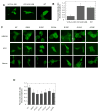Nucleocytoplasmic shuttling of valosin-containing protein (VCP/p97) regulated by its N domain and C-terminal region
- PMID: 25447673
- PMCID: PMC4254625
- DOI: 10.1016/j.bbamcr.2014.10.019
Nucleocytoplasmic shuttling of valosin-containing protein (VCP/p97) regulated by its N domain and C-terminal region
Abstract
Valosin-containing protein (VCP or p97), a member of the AAA family (ATPases associated with diverse cellular activities), plays a key role in many important cellular activities. A genetic deficiency of VCP can cause inclusion body myopathy associated with Paget's disease of bone and frontotemporal dementia (IBMPFD). Previous studies showed that the VCP N domain is essential for the regulation of nuclear entry of VCP. Here we report that IBMPFD mutations, which are mainly located in the N domain, suppress the nuclear entry of VCP. Moreover, the peptide sequence G780AGPSQ in the C-terminal region regulates the retention of VCP in the nucleus. A mutant lacking this sequence can increase the nuclear distribution of IBMPFD VCP, suggesting that this sequence is a potential molecular target for correcting the deficient nucleocytoplasmic shuttling of IBMPFD VCP proteins.
Keywords: Inclusion body myopathy associated with Paget's disease of bone and frontotemporal dementia (IBMPFD); Nuclear export signal; Nucleocytoplasmic shuttling; Valosin containing protein.
Copyright © 2014 Elsevier B.V. All rights reserved.
Figures









Similar articles
-
Valosin-containing protein (VCP) is a novel IQ motif-containing GTPase activating protein 1 (IQGAP1)-interacting protein.Biochem Biophys Res Commun. 2017 Dec 2;493(4):1384-1389. doi: 10.1016/j.bbrc.2017.09.159. Epub 2017 Sep 29. Biochem Biophys Res Commun. 2017. PMID: 28970065
-
Valosin-Containing Protein (VCP)/p97 Oligomerization.Subcell Biochem. 2024;104:485-501. doi: 10.1007/978-3-031-58843-3_18. Subcell Biochem. 2024. PMID: 38963497 Review.
-
IBMPFD Disease-Causing Mutant VCP/p97 Proteins Are Targets of Autophagic-Lysosomal Degradation.PLoS One. 2016 Oct 21;11(10):e0164864. doi: 10.1371/journal.pone.0164864. eCollection 2016. PLoS One. 2016. PMID: 27768726 Free PMC article.
-
A novel VCP mutation as the cause of atypical IBMPFD in a Chinese family.Bone. 2013 Jan;52(1):9-16. doi: 10.1016/j.bone.2012.09.012. Epub 2012 Sep 19. Bone. 2013. PMID: 23000505
-
Inclusion body myopathy, Paget's disease of the bone and fronto-temporal dementia: a disorder of autophagy.Hum Mol Genet. 2010 Apr 15;19(R1):R38-45. doi: 10.1093/hmg/ddq157. Epub 2010 Apr 21. Hum Mol Genet. 2010. PMID: 20410287 Free PMC article. Review.
Cited by
-
VCP promotes tTAF-target gene expression and spermatocyte differentiation by downregulating mono-ubiquitylated H2A.Development. 2023 Jul 15;150(14):dev201557. doi: 10.1242/dev.201557. Epub 2023 Jul 19. Development. 2023. PMID: 37401420 Free PMC article.
-
Functional Inhibition of Valosin-Containing Protein Induces Cardiac Dilation and Dysfunction in a New Dominant-Negative Transgenic Mouse Model.Cells. 2021 Oct 26;10(11):2891. doi: 10.3390/cells10112891. Cells. 2021. PMID: 34831118 Free PMC article.
-
Nuclear VCP drives colorectal cancer progression by promoting fatty acid oxidation.Proc Natl Acad Sci U S A. 2023 Oct 10;120(41):e2221653120. doi: 10.1073/pnas.2221653120. Epub 2023 Oct 3. Proc Natl Acad Sci U S A. 2023. PMID: 37788309 Free PMC article.
-
Disruption of valosin-containing protein activity causes cardiomyopathy and reveals pleiotropic functions in cardiac homeostasis.J Biol Chem. 2019 May 31;294(22):8918-8929. doi: 10.1074/jbc.RA119.007585. Epub 2019 Apr 21. J Biol Chem. 2019. PMID: 31006653 Free PMC article.
-
Proteinopathies as Hallmarks of Impaired Gene Expression, Proteostasis and Mitochondrial Function in Amyotrophic Lateral Sclerosis.Front Neurosci. 2021 Dec 23;15:783624. doi: 10.3389/fnins.2021.783624. eCollection 2021. Front Neurosci. 2021. PMID: 35002606 Free PMC article. Review.
References
-
- Wang Q, Song C, Li CC. Molecular perspectives on p97-VCP: progress in understanding its structure and diverse biological functions. J Struct Biol. 2004;146:44–57. - PubMed
-
- Meyer H, Bug M, Bremer S. Emerging functions of the VCP/p97 AAA-ATPase in the ubiquitin system. Nat Cell Biol. 2012;14:117–123. - PubMed
-
- Yamanaka K, Sasagawa Y, Ogura T. Recent advances in p97/VCP/Cdc48 cellular functions. Biochim Biophys Acta. 2012;1823:130–137. - PubMed
Publication types
MeSH terms
Substances
Supplementary concepts
Grants and funding
LinkOut - more resources
Full Text Sources
Other Literature Sources
Miscellaneous

